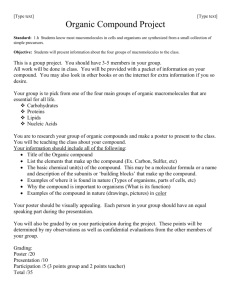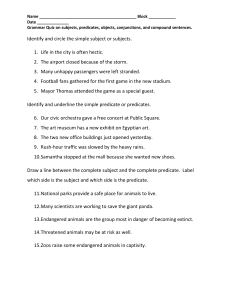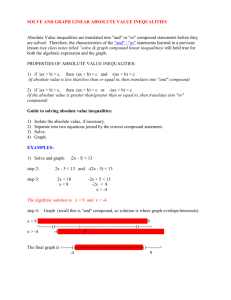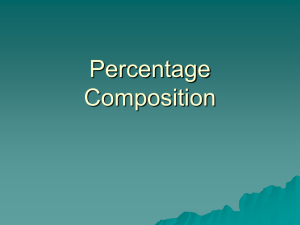7th ELA 2nd 4.5 Study Guide - Social Circle City Schools
advertisement
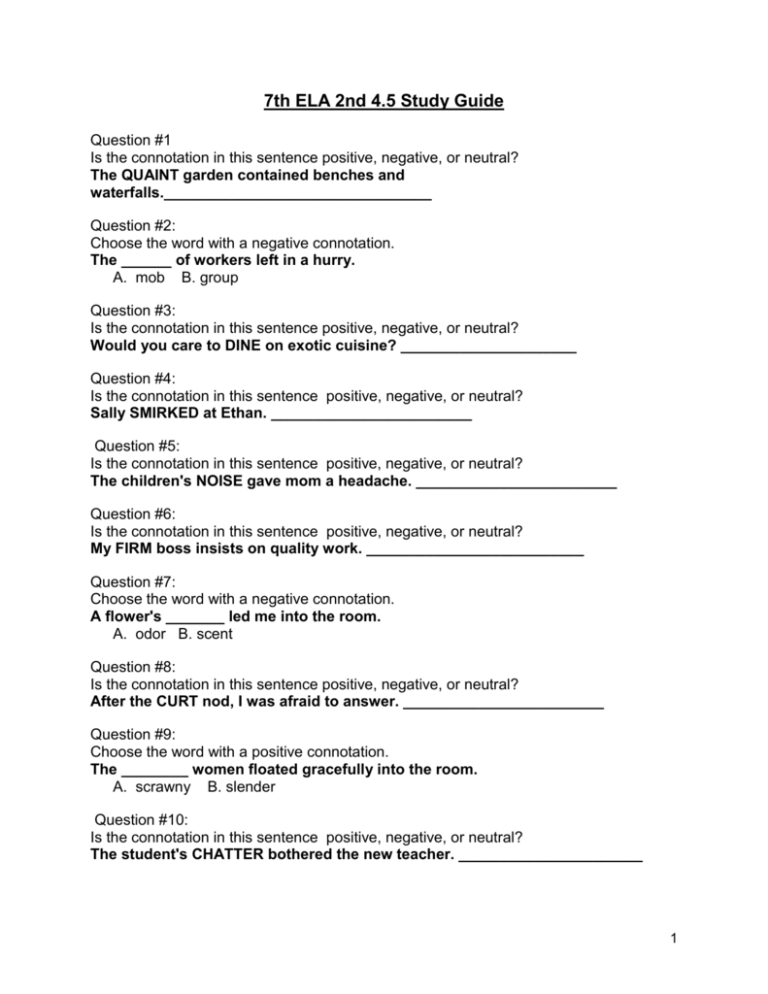
7th ELA 2nd 4.5 Study Guide Question #1 Is the connotation in this sentence positive, negative, or neutral? The QUAINT garden contained benches and waterfalls.________________________________ Question #2: Choose the word with a negative connotation. The ______ of workers left in a hurry. A. mob B. group Question #3: Is the connotation in this sentence positive, negative, or neutral? Would you care to DINE on exotic cuisine? _____________________ Question #4: Is the connotation in this sentence positive, negative, or neutral? Sally SMIRKED at Ethan. ________________________ Question #5: Is the connotation in this sentence positive, negative, or neutral? The children's NOISE gave mom a headache. ________________________ Question #6: Is the connotation in this sentence positive, negative, or neutral? My FIRM boss insists on quality work. __________________________ Question #7: Choose the word with a negative connotation. A flower's _______ led me into the room. A. odor B. scent Question #8: Is the connotation in this sentence positive, negative, or neutral? After the CURT nod, I was afraid to answer. ________________________ Question #9: Choose the word with a positive connotation. The ________ women floated gracefully into the room. A. scrawny B. slender Question #10: Is the connotation in this sentence positive, negative, or neutral? The student's CHATTER bothered the new teacher. ______________________ 1 Question #11: Is the connotation in this sentence positive, negative, or neutral? The INQUISITIVE child was not afraid to ask questions. ______________________ Question #12: Choose the word with the negative connotation. That _______ cologne filled the room. A. inexpensive B. cheap Summary and Main Idea Directions: Read each passage and… A. B. C. D. E. Create a title for the passage related to the main idea. Accurately summarize the text. Your summary must describe all key ideas from the text. DO NOT include opinions or personal info in your summary. Highlight or underline key ideas in each passage. Picture this: a herd of elephants flies past you at sixty miles per hour, followed by a streak of tigers, a pride of lions, and a bunch of clowns. What do you see? It must be a circus train! One of the first uses of the circus train is credited to W.C. Coup. He partnered with P.T. Barnum in 1871 to expand the reach of their newly combined shows using locomotives. Before circus trains, these operators had to lug around all of their animals, performers, and equipment with a team of more than 600 horses. Since there were no highways, these voyages were rough and took a long time. Circuses would stop at many small towns between the large venues. Performing at many of these small towns was not very profitable. Because of these limitations, circuses could not grow as large as the imaginations of the operators. After they began using circus trains, Barnum and Coup only brought their show to large cities. These performances were much more profitable and the profits went toward creating an even bigger and better circus. Multiple rings were added and the show went on. Today, Ringling Bros. and Barnum and Bailey Circus still rely on the circus train to transport their astounding show, but now they use two. 13. Main idea related title for the passage: 14. Summarize the passage in your own words: 2 How do you say “Holy cow” in French? The fastest thing in France may just be the fastest ground transportation in the world. The TGV (Train à Grande Vitesse: French for very high speed) is France’s national high speed rail service. On April 3rd, 2007, a TGV test train set a record for the fastest wheeled train, reaching 357.2 miles per hour. In mid 2011, TGV trains operated at the highest speed in passenger train service in the world, regularly reaching 200 miles per hour. But what you may find most shocking is that TGV trains run on electric power not petrol. Now if you’ll excuse me; I have a record to catch. 15. Main idea related title for the passage: 16. Summarize the passage in your own words: Giddy-up, cowboys and girls! In the Southwest during early half of the 1800s, cows were only worth 2 or 3 dollars a piece. They roamed wild, grazed off of the open range, and were abundant. Midway through the century though, railroads were built and the nation was connected. People could suddenly ship cows in freight trains to the Northeast, where the Yankees had a growing taste for beef. Out of the blue, the same cows that were once worth a couple of bucks were now worth between twenty and forty dollars each, if you could get them to the train station. It became pretty lucrative to wrangle up a drove of cattle and herd them to the nearest train town, but it was at least as dangerous as it was profitable. Cowboys were threatened at every turn. They faced cattle rustlers, stampedes and extreme weather, but kept pushing those steers to the train station. By the turn of the century, barbed wire killed the open range and some may say the cowboy too, but it was the train that birthed him. 17. Main idea related title for the passage: 3 18. Summarize the passage in your own words: Electric trolley cars or trams were once the chief mode of public transportation in the United States. Though they required tracks and electric cables to run, these trolley cars were clean and comfortable. In 1922, auto manufacturer General Motors created a special unit to replace electric trolleys with cars, trucks, and buses. Over the next decade, this group successfully lobbied for laws and regulations that made operating trams more difficult and less profitable. In 1936 General Motors created several front companies for the purpose of purchasing and dismantling the trolley car system. They received substantial investments from Firestone Tire, Standard Oil of California, Phillips Petroleum, and other parties invested in the automotive industry. Some people suspect that these parties wanted to replace trolley cars with buses to make public transportation less desirable, which would then increase automobile sales. The decline of the tram system in North America could be attributed to many things—labor strikes, the Great Depression, regulations that were unfavorable to operators—but perhaps the primary cause was having a group of powerful men from rival sectors of the auto industry working together to ensure its destruction. Fill it up, please. 19. Main idea related title for the passage: 20. Summarize the passage in your own words: Nonfiction Reading “Garbage” Directions: Read the following passage and answer the questions that follow. Refer to the text to check your answers when appropriate. 4 (1) Garbage cans are not magical portals. Trash does not disappear when you toss it in a can. Yet, the average American throws away an estimated 1,600 pounds of waste each year. If there are no magic garbage fairies, where does all that trash go? There are four methods to managing waste: recycling, landfilling, composting, and incinerating. Each method has its strengths and weaknesses. Let's take a quick look at each. (2)Recycling is the process of turning waste into new materials. For example, used paper can be turned into paperboard, which can be used to make book covers. Recycling can reduce pollution, save materials, and lower energy use. Yet, some argue that recycling wastes energy. They believe that collecting, processing, and converting waste uses more energy than it saves. Still, most people agree that recycling is better for the planet than landfilling. (3)Landfilling is the oldest method of managing waste. In its simplest form, landfilling is when people bury garbage in a hole. Over time the practice of landfilling has advanced. Garbage is compacted before it is thrown into the hole. In this way more garbage can fit in each landfill. Large liners are placed in the bottom of landfills so that toxic garbage juice doesn't get into the ground water. Sadly, these liners don't always work. Landfills may pollute the local water supply. Not to mention that all of that garbage stinks. Nobody wants to live next to a landfill. This makes it hard to find new locations for landfills. (4)As landfill space increases, interest in composting grows. Compositing is when people pile up organic matter, such as food waste, and allow it to decompose. The product of this decomposition is compost. Compost can be added to the soil to make the soil richer and better for growing crops. While composting is easy to do onsite somewhere, like home or school, it's hard to do after the garbage gets all mixed up. This is because plastic and other inorganic materials must be removed from the compost pile or they will pollute the soil. There's a lot of plastic in garbage, which makes it hard to compost on a large scale. (5)One thing that is easier to do is burning garbage. There are two main ways to incinerate waste. The first is to create or harvest a fuel from the waste, such as methane gas, and burn the fuel. The second is to burn the waste directly. The heat from the incineration process can boil water, which can power steam generators. Unfortunately, burning garbage pollutes the air. Also, some critics worry that incinerators destroy valuable resources that could be recycled. (6)Usually, the community in which you live manages waste. Once you put your garbage in that can, what happens to it is beyond your control. But you can make choices while it is still in your possession. You can choose to recycle, you can choose to compost, or you can choose to let someone else deal with it. The choice is yours. 5 21. Which best explains why the author begins the text by talking about magical garbage fairies? a. He is putting a common misconception to rest. b. He is trying to get the reader's attention. c. He is addressing his concern in a serious way. d. He is supporting his argument with evidence. 22. Which best defines the meaning of incineration as it is used in the text? a. To bury waste materials in a large hole b. To allow waste products to decompose and become fertilizer c. To burn waste materials and harvest the energy d. To turn waste materials into products like book covers 23. Which was not cited in the third paragraph as an issue with landfilling? a. Landfills are smelly. b. Usable materials are wasted in landfills. c. Landfills may pollute the water supply.d. It is difficult to find locations for landfills. 24. Which conclusion could best be supported with text from the passage? a. Each method of waste management has its drawbacks. b. Recycling is without a doubt the best way to handle waste. c. Incineration is the best way to process waste. d. All large cities should create massive compost piles. 25. Which best expresses the main idea of the fourth paragraph? a. Landfills take up a lot of space. b. Composting is good for the soil but it can be hard to do. c. The process of composting is very complicated and scientific. d. There is a lot of plastic garbage in landfills. 26. Which best expresses the meaning of the word compacted as it is used in the third paragraph? a. Garbage is burned before it is thrown in a hole. b. Garbage is put in trucks before it is thrown in a hole c. Garbage is crushed smaller before it is thrown in a hole. d. Garbage is put in a can before it is thrown in a hole. 27. Which best expresses the author's main purpose in writing this? a. To convince readers to recycle and compost b. To persuade readers that recycling is a waste of resources c. To compare and contrast recycling and landfilling d. To inform readers of methods of waste management 28. Which is not included in this text? 6 a. A description of how trash is collected b. A description of the uses of compost c. A description of the two methods of incinerating trash d. A description of how landfills have advanced over time 29. Which best explains why composting is not feasible on a large scale? a. People wouldn't want to touch all of that gross rotting food. b. It would smell too bad in densely populated cities. c. It would attract rodents that would spread disease. d. Plastic would get into the compost and turn it into a pollutant. 30. Which title best expresses the main idea of this text? a. The Magic of Recycling: Bringing Back What Was Once Lost b. Methods of Waste Management: Pros and Cons c. Recycling, Landfilling, or Composting: Which is Best For You? d. Do Your Part: How to Save the Earth by Recycling and Composting 31. Which two methods of waste management do you believe are best for society? Support your argument with text. 32. Which two methods of waste management do you believe are worst for society? Refer to the text in your argument. (i.e. Cite evidence). 7 33. Summarize the article. Be sure to cover the pros and cons of the four methods of waste management. Simple and Compound Sentences A simple sentence is a sentence that had one subject part and one predicate part. A compound sentence is a sentence that contains two or more simple sentences joined by and, or, or but. A compound subject has two or more simple subjects that have the same predicate. The subjects are joined by and. A compound predicate is a predicate that has two or more verbs with the same subject. The verbs are connected by and or or. In a compound sentence, use a comma before and, or, or but when they join simple sentences. In a series of three or more nouns or verbs, use commas to separate them. Circle the correct answer. 34. We bought tickets to the hockey game. Simple Compound 8 35. We sat toward the center of the rink. Simple Compound 36. Hockey is a fast game, and fans shriek with excitement. Simple Compound 37. Hockey players are careful, but they still get hurt often. Simple Compound 38. The goalie on each team stays near the end of the rink. Simple Compound 39. Players obey the rules, or they receive penalties. Simple Compound 40. Hockey is a popular sport in many countries around the world. Simple Compound 41. Hockey players move quickly, or they miss a goal. Simple Compound Circle Compound Subject if the sentence has a compound subject. Circle Compound Predicate if the sentence has a compound predicate 42. Fred, Toby, and I formed a hockey team last month. Compound Subject Compound Predicate 43. We bought equipment made uniforms and found an ice rink. Compound Subject 9 Compound Predicate 44. The coach and his assistant helped us at the start. Compound Subject Compound Predicate 45. Toby printed tickets and sold them after school. Compound Subject Compound Predicate 46. Teachers, students and friends came to our first game. Compound Subject Compound Predicate 47. Boys and girls played on each team. Compound Subject Compound Predicate In a compound sentence, use a comma before and, or, or but when they join simple sentences. In a complex sentence, you will find 1 independent clause and 1 or more dependent clauses. Dependent clauses begin with subordinate conjunctions like because, so that, if, since, etc. 48. Kerry called the fire department, and they arrived very quickly. Compound Complex 49. After he got home, my father read us a story. Compound Complex 50. We couldn’t go to the beach because the car broke down. Compound Complex 51. The magician pulled a rabbit from his hat, but the audience did not applaud. Compound Complex 52. The baby elephant followed its mother because the lion was very close. Compound Complex 53. The forest was dark and gloomy, yet the children ran into it fearlessly. Compound 10 Complex 54. The campers stayed in the tent while the cold rain fell. Compound Complex 55. Jane and Louise bought popcorn before the movie started. Compound Complex 56. Peter worked hard on his homework, yet he didn’t finish it. Compound Complex 57. The baseball player ran to second base when the pitcher dropped the ball. Compound Complex 11



